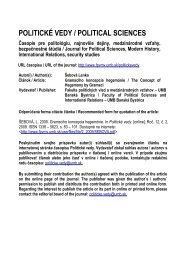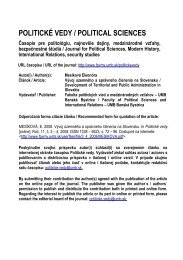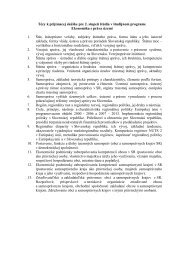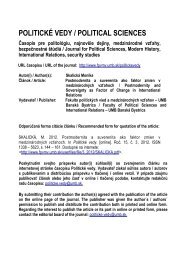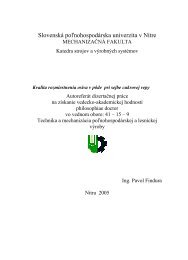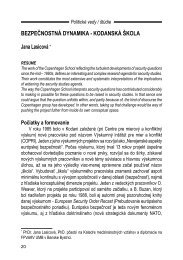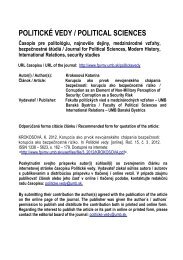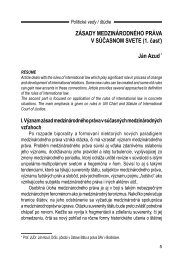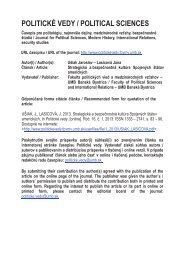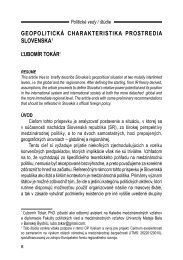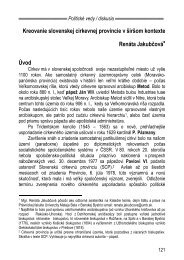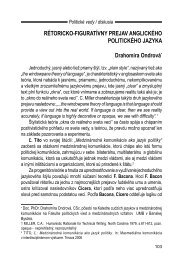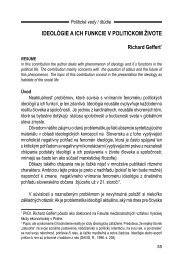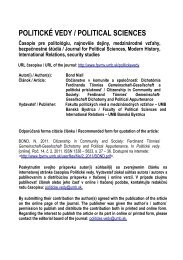MRAVNÃ VÃCHOVA V Å KOLÃCH NA SLOVENSKU A V ZAHRANI ÄÃ
MRAVNÃ VÃCHOVA V Å KOLÃCH NA SLOVENSKU A V ZAHRANI ÄÃ
MRAVNÃ VÃCHOVA V Å KOLÃCH NA SLOVENSKU A V ZAHRANI ÄÃ
You also want an ePaper? Increase the reach of your titles
YUMPU automatically turns print PDFs into web optimized ePapers that Google loves.
At the time (1999-2000) of the work on the Central Framework Curricula (CFC) the idea really<br />
brought up that ethics should be taught instead of Learning about man. The expert committee on the<br />
tuition of ethics, requested by the Minister of Education, also confronted with this idea. The members<br />
of the committee who represented different anthropological studies (mainly ethics) and who had<br />
different world-views 1 defended the earlier (Anthropology and Ethics) conception. The expert<br />
committee definitely concluded that the Learning about man and of ethics and the religious instruction<br />
cannot substitute for each other, they are not foes, not even rivals, and they agreed that the religion can<br />
built upon anthropology and ethics well.<br />
In the end under the term Learning about man and of society, ethics such a subject got into the primary<br />
education of the CFC, which content stands on the basis of the NCC. Both the expert committee both<br />
those teachers who would have taught this subject to more grades and in more weekly contact times<br />
expressed their dissatisfaction with its extent. In consequence of the reduced size of the subject the<br />
moral responsibility casted the burden upon schools. Schools undoubtedly have the opportunity – if<br />
they consider the human and ethics important – to prepare such local curriculum in which this subject<br />
occurs in more grades and with more weekly contact times.<br />
This eminently Hungarian, and at the same time genuine European innovation could not have become<br />
a complete success because in a peculiar way it fell victim to the ideological and pragmatic-rationalist<br />
way of thinking that was born in the reduced spirit of image of human, which inspire both the high<br />
politics and the educational policy 2 .<br />
Present-day heads of education face a dilemma: on the one hand it liberated schools from the CFC that<br />
strongly curtailed their autonomy, on the other hand it has to decide whether it shoulder the identity<br />
with its own, namely with that NCC. From it a quite decided scale of values can be gathered, of which<br />
one of the striking features is exactly Anthropology and Ethics. For the time being it cannot be<br />
experienced that beside the grater freedom the strongly bowdlerised honour of Learning about man<br />
would restore as well.<br />
Until any central notice about Anthropology and Ethics only those schools can be reckoned on in<br />
whose scale of values human and ethics are of great importance, and it does not only become visible in<br />
principled position but also in the number of lessons.<br />
There are also about 50-100 grammar schools where this subject is taught either for four years (5 to 8)<br />
or for two years (7 to 8) as an independent subject, and there are schools where a part (or all) of the<br />
class teacher lessons is put at this subject’s disposal in order to increase the minimum number of<br />
lessons. And there are grammar schools, not more than a dozen, where this subject is taught instead of<br />
the mandatory one year for longer time.<br />
References<br />
AMBRUS A., KÉRI K., 1996. A sokoldalú ember. Budapest, Calibra. p.156 ISBN 963-686-134-3<br />
BERAN F. (ed), 2005. Emberismeret és etika. 2005. Ed. Beran F. Budapest, Szent István Társulat p.<br />
154 ISBN 963-361-328-0<br />
BOHÁR A., 1993. Antropológiai és etikai vázlatok. Budapest, Keraban K. p.213. ISBN 963-8146-65-2<br />
BÓ<strong>NA</strong> G. M. M., 2003. Emberismeret és etika. Budapest, OKKER p.103. ISBN 963-9228-59-1<br />
FALUS K., JAKAB Gy., 2005. Emberismeret és etika. Budapest, Független Pedagógiai Intézet. ISBN<br />
963-86620-7-7<br />
1 The three biggest historical Churches had separate representatives in the committee as well, which had a good<br />
number of religious members besides them.<br />
2 In 1998-ban, at the introduction of the National Core Curriculum about 50 schools started to teach this subject<br />
in at least one hour per week, in about 1000 schools within the scope of Class teacher lesson. Next years the<br />
education of this subject stopped in most of the schools at the news of Framework Curricula, though by 1998<br />
already 800 teachers had finished a 30-60 hour preparatory training.<br />
115



